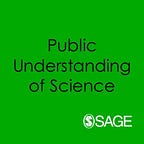Book review
Under the Literary Microscope: science and society in the contemporary novel
Review by Peter Broks
This book is both an introduction and a valuable contribution to the study of the relationship between science, society and fiction
How do people make sense of the science that is embedded into modern life? In most cases, science communication plays only a small part, if any. Instead, the public’s understanding of science is a bricolage of social relationships, personal experiences, cultural references, and information from scientific and non-scientific sources.
In recent years, a key element in that mix has been the rise of science-based literary fiction. Variously described as “science in fiction”, “science novels”, or “lab lit”, this recent turn in fiction is the subject of a new collection of essays. As explained in the introduction, this recent literary phenomenon takes science seriously by offering “explicit, in-depth depictions and explorations of actual scientific research practices — both contemporary and historical — and of the lives and work-worlds of scientists’ characters”.
The work of authors such as Barbara Kingsolver, Ian McEwan, Margaret Atwood, Richard Powers and many others, opens up a creative space “to experience and think critically about the ways that scientific knowledge is generated and used”, according to the editors. The book aims to “examine the public discourse taking place in and around this creative space, focussing on novels that explore the complex social institutions and practices of modern science as well as the labyrinth of economic, political, educational, and moral factors that impact those practices and the knowledge produced”.
The ten essays (plus an introduction) come from authors with a wide range of interdisciplinary backgrounds and interests — principally literary studies but also sociology, science policy, communication, and media and cultural studies. A three-part structure to the book looks at the trinity of science, society and fiction from different angles.
- Part 1 acts as an overview of literary and sociological perspectives on science.
- Part 2 uses the lens of literary fiction to concentrate on the impact of external factors on scientific work and knowledge.
- Part 3 focuses on discussions around the societal outcomes of science.
Within this framework, the chapters begin with a helpful overview of this new wave of literary fiction about science before moving on to examining how fictional images of science reflect science’s organisational transformation from individual labour to collective (and often corporate) production. This is a theme picked up in the subsequent chapter which looks at the persistence of old stereotypes alongside new ones of the scientist-hero(ine) suggesting that “public discourse has finally recognised that science is an integral part of society rather than the prerogative and product of isolated geniuses and madmen”.
In part two, we are shown how character-driven fiction engenders empathy for scientists by presenting them as “enmeshed in complex political, social and economic interactions and restraints that may, and increasingly do, determine the research projects they can undertake”. Chapters in this part of the book also present the reader with “projective realism” as a way to explore the consequences of the economisation of science, as well as the speculative fiction of Margaret Atwood as a contribution to debates on the role of science in society. We also find here a feminist perspective on women scientists in novels — novels which offer personalised stories in the real-world experience of pervasive sexism and bias.
Part three has equally fine chapters but they would probably benefit from a different structure to the book. For example, the chapter on the historical development of science fiction as “visions of a world changed by science” would probably sit more comfortably with some of the chapters in part one. Likewise, the chapter on unruly bio-objects (think Jurassic Park) might spark more associations in the reader if it were to rub against the chapters in part two. This would then leave the fascinating final chapter as a coda to the book since it marks a shift from an analysis of texts to a consideration of the reader.
The idea of the Two Cultures should have been laid to rest long ago, instead of being left to stumble through academia and the media like the undead. In place of Snow’s crude, zombie binarism a much more productive approach adopts the trinity of science, society and the humanities — or, more specifically, if circumstances require: science, society and culture, art, literature etc.
This is exactly what the book does. By examining the creative space opened up by science novels, the book helps, in turn, to open up and establish an interdisciplinary space. The novels and this collection offer multiple perspectives on the relationship between science and society. As such, Under the Literary Microscope is both an introduction and a valuable contribution to the study of the relationship between science, society and fiction.
Peter Broks is Associate Professor of Liberal Arts at the New Model Institute for Technology and Engineering in Hereford, UK. He is the author of Understanding Popular Science (Open University Press, 2006)
